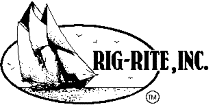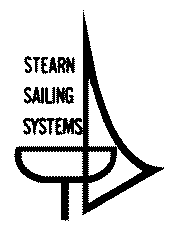 |
Spars, Rigging, and Hardware for SailboatsRig-Rite, Inc. |
 |
Spars, Rigging, and Hardware for SailboatsRig-Rite, Inc. |
| Introduction |
Stearns Twinstay One |
 |
| Features | ||
| System Specifications | ||
| Parts Breakdown | ||
| Accessories | ||
| Bearing Replacement Kits | ||
| Shortening Kits | ||
| Troubleshooting | ||
| Ordering/Pricing |
Introduction
Designed by Tim Stearn as an improvement on his original Hyde System design, and introduced in 1973, the Twinstay One immediately came to dominate the U.S. and international racing circuits. For the first time boats could hoist a new headsail before taking down the old one! This was a revolution in racing circles. Although we take it for granted today, before the Stearns system all sail changes were bald-headed. Other improvements on the earlier system were performance-oriented as well. The narrowing of the rod profile increased its aerodynamic performance by reducing windage, rod and terminal ends were optimized to reduce weight even further, and terminal end design was simplified. Another improvement was an ingenious 'wedge' method for fitting the rod to the terminal ends. This allowed the system to be assembled to its final length on the dock or elsewhere quickly and without the use of special tools. Popular with race boat owners and boat builders alike was the fact that the Twinstay racing foil was designed to be quickly and easily converted to the Dynafurl furling system, with the use of a few additional components. See: Dynafurl One Components. Racers liked the fact that after a regatta, in just a few minutes, their racing foil could be converted to furling for the trip home. Boat builders liked the fact that they could equip their racer/cruisers with the same efficient, Circuit level racing foil and offer an easy furling option. Though 45 years have passed since the introduction of the Dynafurl system, many of its features have not been surpassed by any of the more recently introduced furling systems. All of the modern crop of furling systems are designed around UPS shipping restrictions which limit their maximum section length to about six feet. This basic design constraint creates many problems in addition to increased weight and windage, most of which are due to the necessity of connecting all those short sections back together. Fastening the joints, keeping them from bending or kinking, and keeping the fasteners in place have been problems for many newer systems. The tendency of these systems to chafe the wire forestay, as they spin around it, at the joints and at the end of the extrusion can cause damage leading to snagging and unlaying of the stay. This has caused the loss of many a rig over the years. All of these problems are eliminated by the use of a one-piece solid rod. Stearns systems are still in use on thousands of yachts worldwide, and although new systems are still being made, we frequently get calls from people who bought a used one or who found a system abandoned in a boatyard. Usually all these systems need is a bearing replacement kit or a shortening kit to put them back in use on a new yacht – which they will probably outlast as well. Twinstay systems can easily be converted to furling systems with the addition of a Dynafurl conversion kit. Occasional bearing replacement (on average about 8 years), and periodic inspection are all that is necessary to keep this system in top form indefinitely. ~ Top ~ |
|
|
Features
~ Top ~ |
|
|
|||||||||||||||||||||||||||||||||||||||||||||||||||||||||||||||||||||||||||||||||||||||||||||||||||||||||||||||||||||||||||||||||||||||||||||||||||||||||||
System SpecificationsThe Stearns Twinstay One is a rotating twin-luff support system with an elliptical, aluminum, one-piece, solid rod luff extrusion, with two luff grooves on opposite sides. The solid rod replaces the conventional wire forestay. The Stearns Dynafurl One is a furling system made by adding a halyard swivel and a drum and drum cover assembly to a Stearns Twinstay One, see: Dynafurl One Components.
* #6 Rod is out of
production. All other parts are available.
~ Top ~ |
|||||||||||||||||||||||||||||||||||||||||||||||||||||||||||||||||||||||||||||||||||||||||||||||||||||||||||||||||||||||||||||||||||||||||||||||||||||||||||
|
|
|||||||||||||||||||||||||||||||||||||||||||||||||||||||||||||||||||||||||||||||||||||||||||||||||||||||||||||||||||||||||||||||||||||||||||||||||||||||||||
Twinstay One ComponentsFor complete Part Numbers, additional Data, and
Pricing, See Stearns System Pricing, below.
~ Top ~ |
||||||||||||||||||||||||||||||||||||||||||||||
|
|
||||||||||||||||||||||||||||||||||||||||||||||
Dynafurl One ComponentsFor complete Part Numbers, additional Data, and
Pricing, See Stearns System Pricing, below.
Dynafurl One Halyard Swivel Complete
Stearn # * -30 Dynafurl One Drum & Drum Cover Set Complete Stearn # * -40 Complete Drum and Drum Cover Assemblies with fasteners for Stearns Dynafurl One. Dynafurl One Fittings Complete
Stearn # * -50 ~ Top ~ |
||||||||||||||||||||||||||||||||||||||||||||||
|
|
|||||
Bearing Replacement KitsWith a little easy maintenance and occasional bearing replacement, your Stearns System should last several lifetimes. Bearings are easily replaced by any individual who is mechanically inclined and has the ability to follow instructions. The system must be down in order to do a complete bearing replacement. To purchase bearings and components that go inside the ends of the system, you will need to know your system size, and, for System sizes #8 - #14, additional data listed below. Then, See Stearns System Pricing. Stearns Systems size #8 has been produced with 2 different End Bearing Arrangements. Earlier systems used 3 bearings per end, newer systems used 1 stronger bearing per end. The only way to tell which type you have is to disassemble them (See: Terminal End Bearing Removal, below. You will need a 1/16" Allen wrench). The two Bearing types are not interchangeable, nor are any other of the Terminal End components. Stearns Systems sizes #9 - #14 have been produced with 2 different Terminal
Body Types, Tapered & Cylindrical. Earlier systems used the Tapered
Terminal Ends. The two Bearing types are not interchangeable, nor are any other of the
Terminal End components.
Terminal End Bearing
Removal - Applies to Both ends of all Twinstay One/Dynafurl One Systems.
2. Locate the vertical holes (2) in the Deck Eye. Insert (2) Pins into the Deck Eye holes and rotate the Deck Eye to engage corresponding holes in the Terminal Cap beneath it. When Pins are engaged, rotate the Deck Eye to unthread the Terminal Cap from the Terminal Body. 3. You have now removed the Deck Eye with Terminal Cap, Bearing stack and Lock Nut from the Terminal Body. Put the Deck Eye in a vise and remove Lock Nut to access Bearings. ~ Top ~ |
|
|
||||
Shortening KitsShortening Kits are used to reduce overall system length, when modifying the rig or transferring the system to another boat. It is the upper end that is usually shortened so as not to change the height of the sail feed entrance.
~ Top ~ |
||||
|
|
||||||||||||||||||||
|
Heavy Duty Jaw/Jaw Toggle
~ Top ~ |
|
|
||
TroubleshootingThe standard considerations in all furling system installations are:
If you are experiencing trouble with your Stearns system that is not related to any of those items above, it is usually one of the following problems:
~ Top ~ |
|
|
||
Ordering/Pricing
To place an Order, See Ordering, you will need Part Numbers. Complete Systems Pricing – Specify size, system length, pin diameters, and shipping destination and contact us for a quote. As these systems must be shipped full length, and shipping options are limited, please allow extra time for shipping arrangements and delivery. |
~ Top ~
~ Back to Furling Systems Main Page ~
~ Home ~